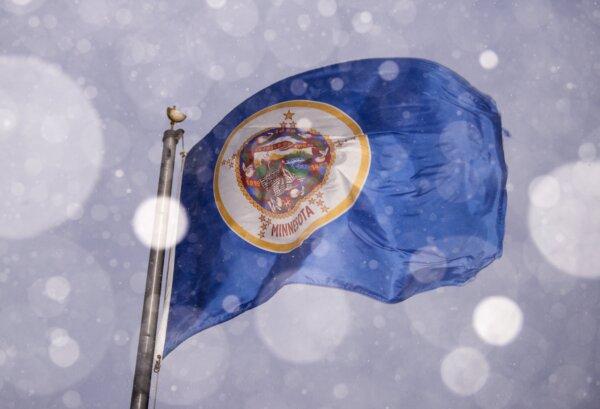A flag design preliminarily picked to replace Minnesota’s current state flag triggered a backlash on social media for its similarities with a Somalia regional flag. It’s now been rejected in favor of a different design.
A 13-member State Emblems Redesign Commission was tasked with developing a new state flag after the old design was deemed racist. It showed a seal with a white settler plowing a field and a Native American riding away into the sunset on a horse.
One state lawmaker called it a “cluttered genocidal mess,” and sponsored the bill to replace it.
The latest flag flap began after the commission announced the preliminary selection of a new flag design on Dec. 15. It had a simplified shape of Minnesota on the left in dark blue, with an eight-point star representing the North Star in the center of the blue. To the right were three stacked bars—one light blue, one white, and one green.
When unveiled, critics raged online that the new design closely resembled the flag from the Puntland state of Somalia. That regional flag has a blue, a white, and a green bar, with a white star centered at the top.
Minnesota has a large population of Somalis. And Rep. Ilhan Omar (D-Minn.) tells of coming to America as a refugee from Somalia.
She represents the state’s 5th Congressional District and gained notoriety as part of The Squad, an informal group of eight outspoken Democrats in the U.S. House of Representatives.
For days, tempers flared across social media over the proposed revamp of the flag.
And at a commission meeting on Dec. 20, several members of the redesign committee acknowledged the controversy.
Ultimately, instead of moving forward with the controversial design, the committee backed away and adopted another. It has a white star representing the North Star on a dark blue shape representing Minnesota on the left. The remainder of the design on the right is a lighter shade of blue.
Critics on social media were quick to point out that Somalia is the birthplace of Ilhan Omar, a Democrat representing Minnesota in Congress. She’s one of two Muslim women serving in the U.S. House of Representatives and often caucuses with socialist factions of her party.
“Minnesota is home to the largest Somali population in the West,” the post stated, noting Ms. Omar’s connection to Somalia, as well. The post mockingly surmised the similarities between the flag designs were “just a coincidence.”
That irked some Americans, who commented that they viewed the proposed design as a reflection of an overseas country, rather than a U.S. state.

Comments on the post mostly condemned the Somali flag look-alike, which many said amounted to a foreign takeover.
“The Somali pirates are now taking states,” one X user lamented.
“The United States is losing its identity, and Minnesota is an example,” another complained.
“Replacement Theory sure doesn’t seem to (sic) much of a ’theory' anymore,” wrote another.
“And I hate to break it to the rightwing crazies, but I had nothing to do with the new design,” she wrote.
The Minnesota Legislature, which Democrats control, passed legislation requiring the creation of a new flag and state seal after the old flag was deemed offensive.
Critics interpreted the scene as one where defeated Native Americans were leaving, while victorious whites were claiming the land.
That’s what prompted the main sponsor of the bill to require scrapping the current flag—state Rep. Mike Freiberg, a Democrat—to call out the design as “a cluttered genocidal mess.”

Questioning Claims of Racism
But Mike Gonzalez, a senior fellow at the Heritage Foundation, questioned why the flag was considered racist in the first place. Mr. Gonzalez writes about Critical Race Theory (CRT) and identity politics.“This isn’t about the flag,” he said. “It’s about destabilizing the family. It’s about destabilizing the nation-state. It’s about destabilizing the system.”
Every civilization has undergone periods of conquest, with different cultures claiming land throughout the ages, he said.
The United Kingdom was inhabited by Celts, Romans, Anglo-Saxons, Vikings, and Normans, he noted. And the Romans, Arabs, and Visigoths conquered Spain over the ages.
“We tie ourselves in knots” trying to assign morality to cyclical invasions, he said.
Changing flags, names on buildings, and removing statues are part of one common goal—to tear down Western civilization, he said. And that is furthered as people, he said, buy into “the big lie” that America is systemically racist.
The current efforts to remake the West are being energized by neo-Marxist ideals, he said, and that left-wing factions want to replace America’s system as outlined by the Founding Fathers. They aim to tear down the American legal system, free market economy, and concept of citizens’ universal rights, he said, and replace all of that with a centralized Marxist government.

The commission addressing the flag redesign includes members of the state’s tribal communities and “people of color.” The group was given a deadline of producing new designs for the flag and seal by Jan. 1, 2024.
Barring rejection by the Legislature, the new emblems automatically become official on April 1, 2024—the day Minnesotans observe Statehood Day.
Earlier in December, the commission settled on a new design for the state seal featuring a loon and the Dakota tribe’s name for Minnesota, Mni Sóta Makoce. That’s translated as “where the water meets the sky.”
Minnesota’s actions follow those of other states.
Utah’s Legislature approved a simplified flag design in 2022 that still includes a beehive, a symbol of the prosperity and industry of the Mormon pioneers who settled the state.
In 2020, Mississippi voters selected a new state flag with a magnolia flower and the phrase “In God We Trust.” The design replaced a Confederate-themed flag that Ku Klux Klan groups used. Critics had condemned it as racist.







